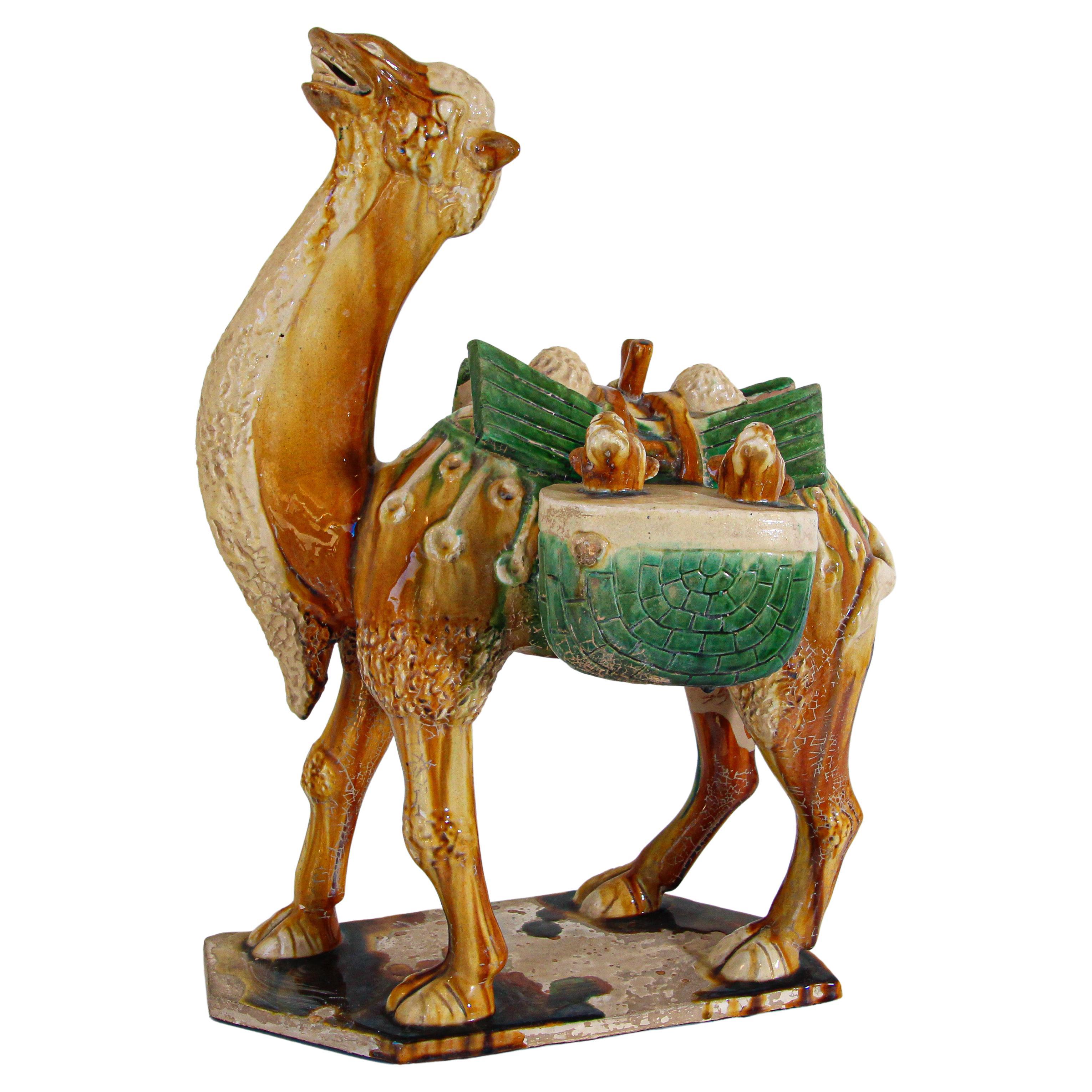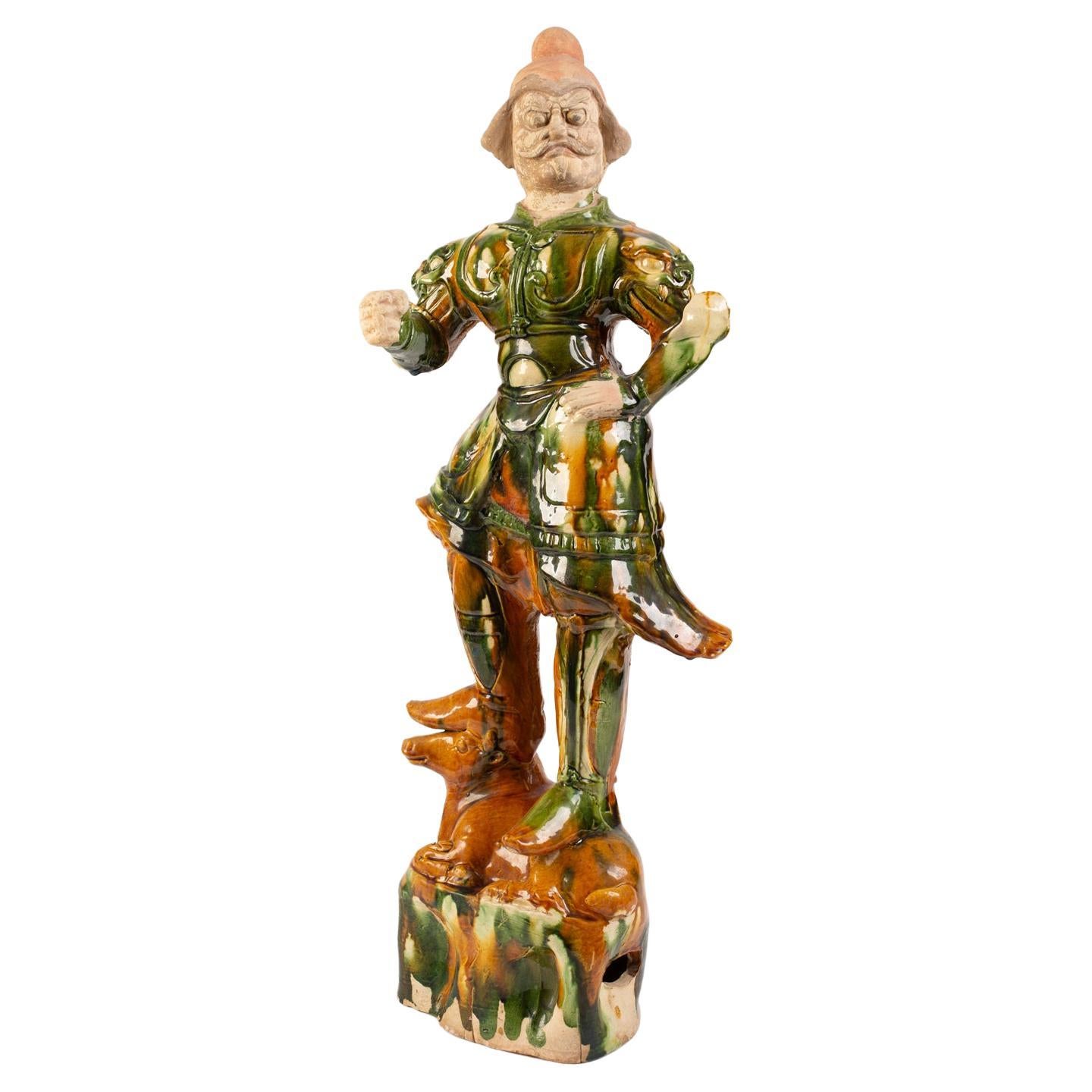Items Similar to Pair of Tang Dynasty Sancai Glazed Tomb Guardians, Zhenmushou, 7th-8th Century
Want more images or videos?
Request additional images or videos from the seller
1 of 16
Pair of Tang Dynasty Sancai Glazed Tomb Guardians, Zhenmushou, 7th-8th Century
About the Item
A fantastic and powerful pair of Chinese Tang Dynasty three-color (sancai) glazed zhenmushou, tomb guardian figures, late 7th or early 8th century. TL tested by Oxford Authentication, 1998.
The fierce, mythical creatures are masterfully composed. They are portrayed perched upon hollow rock-work bases, seated firmly on their haunches, a pair of leaf shaped "wings" rising from their muscular shoulders.
One has a human-like face, mouth closed, with large elephantine ears, a large single horn rising from his head.
The other figure has a leonine face, surrounded by a mane. Its mouth open with sharp teeth bared and topped by a pair of tall antlers.
Both with large mohawk like crests or cockscombs rising from the center of their heads. One shaped like the blade of a halberd, the other shaped like flames.
The figures covered in a stunning sancai (three color) glaze, with cream, amber and green. The glaze with wonderful spots and runs, covering almost the entirety of the figures, save the lower part of the bases, the human-like face, and the large rising crests.
Zhenmushou are chimeric beings that were thought to ward off evil, protecting the occupant and contents of a tomb from physical and spiritual incursions.
For a comparable example of the guardian with the human face, see the Metropolitan Museum of Art, accession number 11.83.4
- Dimensions:Height: 29 in (73.66 cm)Width: 9 in (22.86 cm)Depth: 7 in (17.78 cm)
- Sold As:Set of 2
- Style:Tang (Of the Period)
- Materials and Techniques:Earthenware,Glazed
- Place of Origin:
- Period:
- Date of Manufacture:Late 7th to Early 8th Century
- Condition:Repaired: Repairs and restorations as expected. Wear consistent with age and use. Minor losses. Excellent condition for age. With repairs and restorations as expected. The top of the flange on the leonine figure with small losses.
- Seller Location:Austin, TX
- Reference Number:1stDibs: LU894712492912
About the Seller
5.0
Gold Seller
These expertly vetted sellers are highly rated and consistently exceed customer expectations.
Established in 2001
1stDibs seller since 2010
304 sales on 1stDibs
Typical response time: 1 hour
- ShippingRetrieving quote...Ships From: Austin, TX
- Return PolicyA return for this item may be initiated within 7 days of delivery.
More From This SellerView All
- Tang Dynasty Sancai Glazed Pottery Camel, TL TestedLocated in Austin, TXAn evocative Chinese Tang dynasty (618 to 906 AD) sancai glazed pottery model of a braying camel. The camel is well modeled, standing foursquare upon a rectangular plinth, neck raised, head thrown back, and mouth open in either a defiant, or triumphant, bray. Although sancai means "three color", this particular camel is glazed with only two colors - mostly in amber, with patches of straw glaze mimicking the large patches of fur along the camel's legs, humps, head and neck. TL tested...Category
Antique 15th Century and Earlier Chinese Tang Antiquities
MaterialsPottery
- Chinese Ming Dynasty Sancai Glazed Pottery Guardian Lion, late 16th CenturyLocated in Austin, TXA fantastic Chinese sancai glazed tilework celestial guardian lion, late Ming Dynasty (1368 - 1644), circa late 16th century, China. The charming and ferocious lion is portrayed in ...Category
Antique 16th Century Chinese Ming Sculptures and Carvings
MaterialsPottery, Stoneware
- Pair Chinese Ming Dynasty Glazed Buddhist Lions and Attendants, 17th CenturyLocated in Austin, TXA fantastic pair of large Chinese tileworks sancai glazed Buddhistic lions and attendants, late Ming Dynasty, first half of the 17th century, Shanxi, China. Presented on custom 20th century wood and lacquer table-form stands. This pair of lions and attendants portray Buddhist lions...Category
Antique Mid-17th Century Chinese Ming Sculptures and Carvings
MaterialsCeramic, Wood
- Pair Large Chinese Ming Dynasty Glazed and Painted Pottery Figures, 16th CenturyLocated in Austin, TXA striking pair of large Chinese glazed and painted pottery figures, Ming Dynasty (1368 to 1644), circa 16th century, China. The impressive and realistically modeled figures each portrayed standing upright upon a sancai (three color) glazed pedestal of kang table form. The man is dressed in a short black surcoat over a long robe and pants, a smart cap upon his head. His face is warm and welcoming, with wide eyes and a slight smile on his lips. He holds his hands out in front of him, palms up, almost as if shrugging, though presumably originally holding an object or offering, now lost. The woman of slightly smaller stature, and dressed in a longer surcoat over a long robe and skirt. She wears a fitted cap upon her head. Her hands also held out in front, grasping long lost objects. Her face is slightly more severe, with a somewhat pinched look, and slight frown upon her lips. The size of these figures is remarkable, as is the realism and attention to detail, almost as if they were modeled after real people, as opposed to the more common and generic Ming Dynasty pottery...Category
Antique 16th Century Chinese Ming Sculptures and Carvings
MaterialsPottery
- Pair of Japanese Gilt Wood Komainu, Guardian Lions, Early 20th Century, JapanLocated in Austin, TXA charming and mischievous pair of Japanese carved, gilt and painted komainu, often mistaken for foo dogs or foo lions, Showa Period, 1920's, Japan. The two komainu, or guardian lions, are portrayed seated upon their haunches, heads slightly turned. The two beasts are well carved, with wonderful musculature, flowing manes, and bushy tails. Their faces a mix of ferocious and comical. The eyes of reverse painted glass with gilt highlights. One is a true komainu, (lion-dog), with a horn on its head, and its mouth closed. The other is a shishi, (lion), with its mouth open, and no horn. The komainu sports a mane and tail pigmented blue with gilt highlights. The shishi sports a mane and tail pigmented green with gilt highlights. Both figures richly gilt in gold lacquer. Komainu are protective beings, similar to foo lions or foo dogs...Category
Vintage 1920s Japanese Showa Sculptures and Carvings
MaterialsGlass, Cypress, Wood
- Chinese Ming Dynasty Glazed Tall Attendant Figure, 16th-17th Century, ChinaLocated in Austin, TXA tall Chinese green and amber glazed figure of an attendant, Ming Dynasty, 16th-17th century, China. The figure stands upon an integral plinth, dressed in long robes...Category
Antique 17th Century Chinese Ming Sculptures and Carvings
MaterialsPottery
You May Also Like
- SanCai Glazed Figure of a Camel Chinese Tang Dynasty StyleLocated in North Hollywood, CAVintage Sancai glazed blue pottery figure of a camel Chinese Tang Dynasty manner. A wonderful large Chinese Tang-style glazed pottery figure of a camel carrying goods. Made from tr...Category
Vintage 1950s Chinese Tang Sculptures and Carvings
MaterialsPottery
- Fine Tang Dynasty Pottery Statue of Guardian, TL TestedLocated in Greenwich, CTA very refined, unusual and important lively modeled pottery statue of guardian, dramatic and powerful pose, early Tang dynasty, 618-907AD, comes with Oxford authentication TL test...Category
Antique 15th Century and Earlier Chinese Tang Sculptures and Carvings
MaterialsTerracotta
- Tang Dynasty Sancai Lokapala Guardian with Oxford TL CertificateLocated in Bronx, NYChines Tang Dynasty sancai glazed pottery figure of a Guardian is a protector of the deceased. This warrior dressed in armor with a fierce face and imposing position would accompany ...Category
Antique 15th Century and Earlier Chinese Tang Sculptures and Carvings
MaterialsTerracotta
- Tang Dynasty Sancai Glazed Pottery HorseBy Tang DynastyLocated in Dallas, TXTang Dynasty (618 - 907) Sancai glazed pottery horse The cream-glazed horse is naturalistically modelled standing on a rectangular base, with the mane, tail and hooves highlighted in amber glaze. The head is gracefully curved to the left, with a green and amber glazed saddle and blanket and foliate-shaped plaques detailed with moulded toads suspending from the trappings. Measures: Height: 14.24 Inches (36.2 cm) Width: 15.5 Inches (39.35 cm) Depth: 6 Inches (15.2 cm) Provenance: An English private collection, acquired in Hong Kong in the 1980s A Certificate of Authenticity will accompany this item along with a lucite base. Condition; Excellent with one repair to right side saddle blanket. Some remaining frustrations throughout with areas of oxidation and a fine craquelure throughout. A formidable piece that presents beautifully. Notes: The present sancai horse...Category
Antique 15th Century and Earlier Chinese Tang Animal Sculptures
MaterialsPottery
- China 618-907 AD Tang Dynasty Pair Of Polychromate Earth Spirits ZhenmushouLocated in Miami, FLPair of Earths Spirits "Zhenmushou" from the China Tang Dynasty 618-907 AD. A beautiful and rare pair of "Earths Spirits guardians" from the Yunnan province region in the ancient China. This was created in clay earthenware pottery during the Tang Dynasty period between 618 and 907 AD. Featuring the molded figures of two seated guardians with decorations with polychrome pigmentations. The figures are seated on their haunches with cloven hooves planted firmly on the base looking forward with their front legs in a straight position. Both with face and body alert expressions on a rectangular base. Earth spirits usually appear in pairs, one with a human head and the other with a lion head. Their supernatural powers, indicated by antlers, spiky flanges and flames, enable them to confront evil spirits and protect any precincts within their gaze. Have been believed to protect the living by keeping the spirits of the dead from inappropriately roaming the world outside the tomb. Zhenmushou or guardian deities, developed from a line of protective spirits found normally in pairs at the front of Tang dynasty tombs. They served both to protect the figure from untoward spirits, and the outside world from the roving spirit of the dead. Combining features from a number of animals to form the perfect mythic beast, these mythical creatures were perceived to be the ideal guardians of the dead The semi human faced figure has a measures of 11.25 by 4.5 by 5.75 inches (28.57 x 11.43 x 14.60 Cm). The mythological lion animal figure has a measures of 10 by 5 by 5.8 inches (24.5 x 12.7 x 14.73 Cm). Tang dynasty or Tang Empire, was an imperial dynasty of China that ruled from 618 to 907, with an interregnum between 690 and 705. It was preceded by the Sui dynasty and followed by the Five Dynasties and Tend Kingdoms period. Historians generally regard the Tang as a high point in Chinese civilization, and a the golden age of cosmopolitan culture. Tang territory, acquired through the military campaigns of its early rulers, rivaled that of the Han dynasty. The Li family founded the dynasty, seizing power during the decline and collapse of the Sui Empire and inaugurating a period of progress and stability in the first half of the dynasty's rule. The dynasty was formally interrupted during 690–705 when Empress Wu Zetian seized the throne, proclaiming the Wu Zhou dynasty...Category
Antique 15th Century and Earlier Chinese Tang Antiquities
MaterialsEarthenware, Pottery
- Tang Dynasty Painted Terracotta Sculpture of a LokapalaBy Tang DynastyLocated in Dallas, TXTang Dynasty terracotta Pottery Tomb figure of the Lokapala Warrier Deity. Figure molded wearing heavy armor, standing in a dynamic pose with left arm raised in a threatening gesture...Category
Antique 15th Century and Earlier Chinese Tang Figurative Sculptures
MaterialsTerracotta





